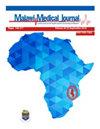Identifying ribonucleotide reductase subunit genes as potential lung adenocarcinomas biomarkers using integrated bioinformatics analysis
IF 1.2
4区 医学
Q4 PUBLIC, ENVIRONMENTAL & OCCUPATIONAL HEALTH
引用次数: 0
Abstract
Introduction Dysregulation of ribonucleotide reductase (RR) subunit genes (RRM1, RRM2 and RRM2B) expression is reported to be involved in the occurrence of various human malignancies. However, the prognostic value of RR subunit genes expression in lung adenocarcinoma (LUAD) patients remains controversial. Objective This study aims to analyze the expression profiles, prognostic values, and immune infiltrating associations of RR subunit genes in LUAD to explore whether RR subunit gene expression has value in the prognosis of patients with lung adenocarcinoma (LUAD).Methodology We used multiple search engines to access multiple online bioinformatics databases, including Oncomine, TIMER, GEPIA, Kaplan–Meier Plotter, PrognoScan, the Human Protein Atlas, MD Anderson Cancer Center, UCSC Xena, cBioProtal, TCGA, GEO, DAVID, and STRING databases.Results The study found that RRM1 and RRM2 might be an attractive target for treating LUAD, while RRM2B were down-expressed in LUAD (P < 0.05). The study also found that high RRM1 or RRM2 expression, or low RRM2B expression suggested poor prognosis of LUAD patients in both TCGA and GEO databases (P < 0.05). Additionally, our results indicated that RR subunit genes expressions have different characteristics with immune infiltrating, RRM2B had a slight but significant positive correlation with almost every infiltrating immune cells except CD4+ T cells (all P < 0.05). Furthermore, by co-expression gene network analysis of RR subunit genes, we found that five new hub genes (PLK1, AURKA, CDCA8, TTK and CDC45) were significantly positively correlated with RRM1 and RRM2 expression whereas were negatively correlated with RRM2B expression, and these five hub genes were identified to be related with a poor prognosis in LUAD patients (P < 0.05). Conclusion The study findings demonstrate that RR subunit genes may be a prognostic marker and therapeutic target for LUAD patients.利用综合生物信息学分析确定核糖核苷酸还原酶亚基基因作为潜在的肺腺癌生物标志物
导言 据报道,核糖核苷酸还原酶(RR)亚基基因(RRM1、RRM2 和 RRM2B)表达失调与多种人类恶性肿瘤的发生有关。然而,肺腺癌(LUAD)患者 RR 亚基基因表达的预后价值仍存在争议。目的 本研究旨在分析 RR 亚单位基因在肺腺癌(LUAD)患者中的表达谱、预后价值和免疫浸润关联,以探讨 RR 亚单位基因的表达对肺腺癌(LUAD)患者的预后是否有价值。方法 我们使用多种搜索引擎访问了多个在线生物信息学数据库,包括 Oncomine、TIMER、GEPIA、Kaplan-Meier Plotter、PrognoScan、人类蛋白质图谱、MD Anderson 癌症中心、UCSC Xena、cBioProtal、TCGA、GEO、DAVID 和 STRING 数据库。 结果 研究发现,RRM1 和 RRM2 可能是治疗 LUAD 的一个有吸引力的靶点,而 RRM2B 在 LUAD 中呈下表达(P < 0.05)。研究还发现,在 TCGA 和 GEO 数据库中,RRM1 或 RRM2 高表达或 RRM2B 低表达提示 LUAD 患者预后不良(P < 0.05)。此外,我们的研究结果表明,RR亚基基因的表达与免疫浸润有不同的特点,RRM2B与除CD4+ T细胞以外的几乎所有浸润免疫细胞都有轻微但显著的正相关(均P < 0.05)。此外,通过对RR亚基基因的共表达基因网络分析,我们发现五个新的中心基因(PLK1、AURKA、CDCA8、TTK和CDC45)与RRM1和RRM2的表达呈显著正相关,而与RRM2B的表达呈负相关,这五个中心基因被确定与LUAD患者的不良预后有关(P<0.05)。结论 研究结果表明,RR亚基基因可能是LUAD患者的预后标志和治疗靶点。
本文章由计算机程序翻译,如有差异,请以英文原文为准。
求助全文
约1分钟内获得全文
求助全文
来源期刊

Malawi Medical Journal
Medicine-General Medicine
CiteScore
1.50
自引率
0.00%
发文量
27
审稿时长
>12 weeks
期刊介绍:
Driven and guided by the priorities articulated in the Malawi National Health Research Agenda, the Malawi Medical Journal publishes original research, short reports, case reports, viewpoints, insightful editorials and commentaries that are of high quality, informative and applicable to the Malawian and sub-Saharan Africa regions. Our particular interest is to publish evidence-based research that impacts and informs national health policies and medical practice in Malawi and the broader region.
Topics covered in the journal include, but are not limited to:
- Communicable diseases (HIV and AIDS, Malaria, TB, etc.)
- Non-communicable diseases (Cardiovascular diseases, cancer, diabetes, etc.)
- Sexual and Reproductive Health (Adolescent health, education, pregnancy and abortion, STDs and HIV and AIDS, etc.)
- Mental health
- Environmental health
- Nutrition
- Health systems and health policy (Leadership, ethics, and governance)
- Community systems strengthening research
- Injury, trauma, and surgical disorders
 求助内容:
求助内容: 应助结果提醒方式:
应助结果提醒方式:


